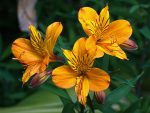 Native to Chile, this tender perennial is a member of the Alstroemeriaceae plant family and a popular cut flower of the floristry industry. It is the hardiest and most vigorous of the genus and is an outstanding garden plant for the border in warmer climates. Growing from a tuberous, spreading root system plants grow up to 3′ tall and have short-petioled lanceolate leaves that are up to 4″ long and carried on strong erect stems. In summer plants produce loose, terminal multibranched umbels of flowers that are 1.5-2″ across, trumpet-shaped, and have a bright orange to gold perianth usually spotted and splashed with red to brown. Many hybrids and selections have expanded the color range of the flowers so that plants with red, pink, lavender, purple, and white flowers are available. The genus name, Alstroemeria, honors Klaus von Alstroemer (1736-1794) who was a Swedish naturalist and student of Karl Linnaeus. The specific epithet, aurea, is the Latin word meaning golden and refers to the flower color.
Native to Chile, this tender perennial is a member of the Alstroemeriaceae plant family and a popular cut flower of the floristry industry. It is the hardiest and most vigorous of the genus and is an outstanding garden plant for the border in warmer climates. Growing from a tuberous, spreading root system plants grow up to 3′ tall and have short-petioled lanceolate leaves that are up to 4″ long and carried on strong erect stems. In summer plants produce loose, terminal multibranched umbels of flowers that are 1.5-2″ across, trumpet-shaped, and have a bright orange to gold perianth usually spotted and splashed with red to brown. Many hybrids and selections have expanded the color range of the flowers so that plants with red, pink, lavender, purple, and white flowers are available. The genus name, Alstroemeria, honors Klaus von Alstroemer (1736-1794) who was a Swedish naturalist and student of Karl Linnaeus. The specific epithet, aurea, is the Latin word meaning golden and refers to the flower color.
Type: Tender perennial
Bloom: Orange to yellow flowers splashed and spotted with darker markings in loose umbels during the summer
Size: 2-3′ H x 1′ W
Light: Full sun to part sun
Soil: Fertile, moderately moist, well-drained
Hardiness: Zones 7-10
Care: Pull stems from base rather than cutting; deadhead
Pests and Diseases: None of significance but susceptible to slugs.
Propagation: Division with great care because roots are brittle; seed
Companion Plants: Veronica longifolia, Jerusalem sage, Verbena bonariensis
Photo Credit: Wikipedia